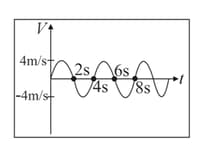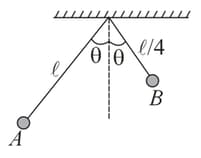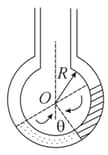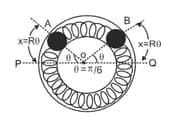Embibe Experts Solutions for Chapter: Simple Harmonic Motion, Exercise 4: Exercise - 4
Embibe Experts Physics Solutions for Exercise - Embibe Experts Solutions for Chapter: Simple Harmonic Motion, Exercise 4: Exercise - 4
Attempt the free practice questions on Chapter 19: Simple Harmonic Motion, Exercise 4: Exercise - 4 with hints and solutions to strengthen your understanding. Alpha Question Bank for Engineering: Physics solutions are prepared by Experienced Embibe Experts.
Questions from Embibe Experts Solutions for Chapter: Simple Harmonic Motion, Exercise 4: Exercise - 4 with Hints & Solutions
If velocity of a particle moving along a straight line changes sinusoidally with time as shown in the given graph, find the average speed over time interval, , being any positive integer.

Two simple pendulums and having lengths and , respectively, are released from the position as shown in figure. Calculate the time after which the release of the two strings become parallel for the first time. The angle is very small.

Two non–viscous, incompressible and immiscible liquids of densities and are poured into the two limbs of a circular tube of radius and small cross–section kept fixed in a vertical plane as shown in fig. Each liquid occupies one–fourth the circumference of the tube.

(a) Find the angle that the radius to the interface makes with the vertical in equilibrium position.
(b) If the whole liquid column is given a small displacement from its equilibrium position, show that the resulting oscillations are simple harmonic. Find the time period of these oscillations.
Two identical balls and , each of mass , are attached to two identical massless springs. The spring–mass system is constrained to move inside a rigid smooth pipe bent in the form of a circle as shown in the figure. The pipe is fixed in a horizontal plane. The centres of the balls can move in a circle of radius . Each spring has a natural length of and spring constant . Initially, both the balls are displaced by an angle radian with respect to the diameter of the circle (as shown in fig.) and released from rest.

(i) Calculate the frequency of oscillation of ball .
(ii) Find the speed of ball when and are at the two ends of the diameter .
(iii) What is the total energy of the system?
Two light springs of force constants and and a block of mass are in one line on a smooth horizontal table such that one end of each spring is fixed to rigid supports and the other end is free as shown in the figure. The distance between the free ends of the spring is . If the block moves along with a velocity in between the springs, calculate the period of oscillation of the block .

Two wheels which are rotated by some external source with constant angular velocity in opposite directions as shown in figure. A uniform plank of mass is placed on it symmetrically. The friction coefficient between each wheel and the plank is . Find the frequency of oscillations, when plank is slightly displaced along its length and released.

The Cubic Potential: Consider a particle of mass moving in one dimension under the influence of potential energy Here and a are real and positive.
(a) Sketch typical plots of and identify extrema if any.
(b) Consider the case where (in appropriate units) we have and Sketch the potential energy . If the total energy of the particle moving in this one-dimensional potential is (in same units), discuss the motion of the particle in terms of allowed regions, boundedness and periodicity.
A body hanging from a spring (figure) is stretched beyond its rest position and released at time to oscillate up and down. Its position at any later time is . What are its velocity and acceleration at time ?

